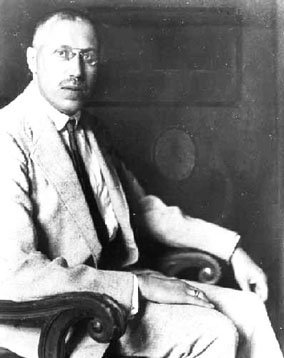Hans Hahn (nonfiction): Difference between revisions
(Created page with "[[]]'''Hans Hahn''' (German: [haːn]; 27 September 1879 – 24 July 1934) was an Austrian mathematician who made contributions to functional analysis, topology, Set theory (...") |
No edit summary |
||
| (3 intermediate revisions by the same user not shown) | |||
| Line 1: | Line 1: | ||
[[]]'''Hans Hahn''' (German: [haːn]; 27 September 1879 – 24 July 1934) was an Austrian mathematician who made contributions to functional analysis, topology, [[Set theory (nonfiction)|set theory]], the calculus of variations, real analysis, and order theory. | [[File:Hans_Hahn.jpg|thumb|Hans Hahn circa 1905.]]'''Hans Hahn''' (German: [haːn]; 27 September 1879 – 24 July 1934) was an Austrian mathematician who made contributions to functional analysis, topology, [[Set theory (nonfiction)|set theory]], the calculus of variations, real analysis, and order theory. | ||
In 1902 he took his Ph.D. in Vienna, on the subject "Zur Theorie der zweiten Variation einfacher Integrale". He was a student of [[Gustav von Escherich (nonfiction)|Gustav von Escherich]]. | |||
Hahn's contributions to mathematics include the Hahn–Banach theorem and (independently of Banach and Steinhaus) the uniform boundedness principle. Other theorems include: | |||
* the Hahn decomposition theorem; | |||
* the Hahn embedding theorem; | |||
* the Hahn–Kolmogorov theorem; | |||
* the Hahn–Mazurkiewicz theorem; | |||
* the Vitali–Hahn–Saks theorem. | |||
He was also interested in philosophy, and was part of a discussion group concerning [[Ernst Mach (nonfiction)|Ernst Mach]]'s positivism with Otto Neurath and Phillip Frank prior to the First World War. In 1922, he helped arrange Moritz Schlick's entry into the group, which led to the founding of the Vienna Circle, the group that was at the center of logical positivist thought in the 1920s. | |||
His most famous student was [[Kurt Gödel (nonfiction)|Kurt Gödel]], whose Ph.D. thesis was completed in 1929. | |||
== In the News == | == In the News == | ||
| Line 9: | Line 23: | ||
* [[Crimes against mathematical constants]] | * [[Crimes against mathematical constants]] | ||
* [[Gnomon algorithm]] | |||
* [[Gnomon Chronicles]] | |||
* [[Mathematician]] | |||
* [[Mathematics]] | |||
== Nonfiction cross-reference == | == Nonfiction cross-reference == | ||
* [[Gustav von Escherich (nonfiction)]] | |||
* [[Kurt Gödel (nonfiction)]] - doctoral advisee | * [[Kurt Gödel (nonfiction)]] - doctoral advisee | ||
* [[Ernst Mach (nonfiction)]] | |||
* [[Mathematician (nonfiction)]] | * [[Mathematician (nonfiction)]] | ||
* [[Mathematics (nonfiction)]] | |||
External links: | External links: | ||
| Line 19: | Line 40: | ||
* [https://en.wikipedia.org/wiki/Hans_Hahn_(mathematician) Hans Hahn] @ Wikipedia | * [https://en.wikipedia.org/wiki/Hans_Hahn_(mathematician) Hans Hahn] @ Wikipedia | ||
[[Category:Nonfiction (nonfiction)]] | [[Category:Nonfiction (nonfiction)]] | ||
[[Category:Mathematicians (nonfiction)]] | [[Category:Mathematicians (nonfiction)]] | ||
[[Category:People (nonfiction)]] | [[Category:People (nonfiction)]] | ||
Latest revision as of 08:58, 24 July 2018
Hans Hahn (German: [haːn]; 27 September 1879 – 24 July 1934) was an Austrian mathematician who made contributions to functional analysis, topology, set theory, the calculus of variations, real analysis, and order theory.
In 1902 he took his Ph.D. in Vienna, on the subject "Zur Theorie der zweiten Variation einfacher Integrale". He was a student of Gustav von Escherich.
Hahn's contributions to mathematics include the Hahn–Banach theorem and (independently of Banach and Steinhaus) the uniform boundedness principle. Other theorems include:
- the Hahn decomposition theorem;
- the Hahn embedding theorem;
- the Hahn–Kolmogorov theorem;
- the Hahn–Mazurkiewicz theorem;
- the Vitali–Hahn–Saks theorem.
He was also interested in philosophy, and was part of a discussion group concerning Ernst Mach's positivism with Otto Neurath and Phillip Frank prior to the First World War. In 1922, he helped arrange Moritz Schlick's entry into the group, which led to the founding of the Vienna Circle, the group that was at the center of logical positivist thought in the 1920s.
His most famous student was Kurt Gödel, whose Ph.D. thesis was completed in 1929.
In the News
Fiction cross-reference
Nonfiction cross-reference
- Gustav von Escherich (nonfiction)
- Kurt Gödel (nonfiction) - doctoral advisee
- Ernst Mach (nonfiction)
- Mathematician (nonfiction)
- Mathematics (nonfiction)
External links:
- Hans Hahn @ Wikipedia
